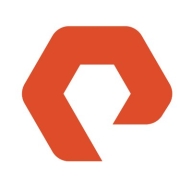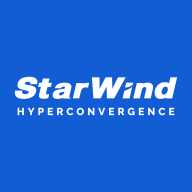


Red Hat Ceph Storage and StarWind Virtual Tape Library are data storage solutions. StarWind Virtual Tape Library has the upper hand due to superior customer satisfaction with pricing and support, alongside standout features that support its value.
Features: Red Hat Ceph Storage offers robust scalability, seamless integration, and high availability. StarWind Virtual Tape Library excels with optimized backup processes, superior speed in data recovery, and enhanced data protection.
Room for Improvement: Red Hat Ceph Storage could refine user interfaces, enhance documentation for complex setups, and expedite support response times. StarWind Virtual Tape Library might improve initial technical deployment, expand compatibility with additional software, and reduce maintenance complexity.
Ease of Deployment and Customer Service: Red Hat Ceph Storage's flexible deployment supports diverse environments with strong infrastructure integration and comprehensive documentation. StarWind Virtual Tape Library ensures rapid installation with user-friendly setup and proactive customer service.
Pricing and ROI: Red Hat Ceph Storage's higher initial setup cost provides commendable ROI over time through scalability. StarWind Virtual Tape Library offers a budget-friendly setup and emphasizes quicker ROI with fast deployment and effective data management.
| Product | Market Share (%) |
|---|---|
| Red Hat Ceph Storage | 18.1% |
| Pure Storage FlashBlade | 3.8% |
| StarWind Virtual Tape Library | 2.0% |
| Other | 76.1% |



| Company Size | Count |
|---|---|
| Small Business | 11 |
| Midsize Enterprise | 11 |
| Large Enterprise | 21 |
| Company Size | Count |
|---|---|
| Small Business | 13 |
| Midsize Enterprise | 4 |
| Large Enterprise | 15 |
FlashBlade is the industry’s most advanced scale-out storage for unstructured data, powered by a modern, massively parallel architecture to consolidate complex data silos (like backup appliances and data lakes) and accelerate tomorrow’s discoveries and insights.
For SMB and Enterprises, who either look to get rid of backup tapes completely, or are willing to accelerate backup process and add an extra level of protection, our solution is StarWind Virtual Tape Library (VTL). It is an appliance that eliminates the need in physical tape and “pretends” to be a supported tape drive or autoloader, keeping all data on inexpensive, fast and high-capacity spinning disks.
Even with explosive data growth, StarWind VTL fits the backup into backup window by accelerating it, so the process does not overlap with production time. Optionally, it creates additional copy of backup data for better safety. It is also available in a software-only form, as part of StarWind VSAN functionality.
StarWind VTL targets those, who need to replace existing tape backup infrastructure or accelerate it if regulatory requirements prohibit replacement. In case the goal is just virtualizing tape backup or creating a stretched backup infrastructure, StarWind Tape Redirector will come in handy.
We monitor all Software Defined Storage (SDS) reviews to prevent fraudulent reviews and keep review quality high. We do not post reviews by company employees or direct competitors. We validate each review for authenticity via cross-reference with LinkedIn, and personal follow-up with the reviewer when necessary.